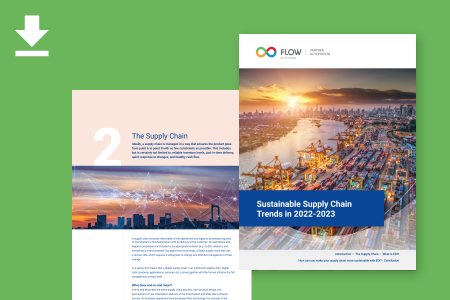February 28th, 2021
Did you know that by exchanging your business documents electronically, as opposed to relying on paper processes, that you’re saving trees? Of course you did!
The majority of service providers that offer EDI and electronic invoicing solutions will tell you this redundant fact (including us!). After all, it is one of the many environmental reasons to go paperless. But when it comes to developing a sustainable supply chain strategy, there are much bigger priorities. Quite frankly, the paperless argument isn’t going to cut it as a reason for your company to invest in an advanced EDI solution from a pure sustainability standpoint.
As discussed in a previous blog, EDI isn’t what it used to be. AI and machine learning technologies have revolutionized the potential of electronic document exchange in terms of cost and error reduction via automation, enhanced validation, increased efficiency, and so on. One thing that’s underexposed, though, is how the aggregated data from these seemingly superficial processes actually has a deeper value. Aside from the obvious paperless benefits, an advanced EDI solution, when integrated with other core business systems, can result in actionable insights to further your sustainable supply chain efforts.
More Environmental Reasons to Go Paperless
There’s a lot to consider at every stage of developing a sustainable supply chain strategy, and you might have noticed that we’ve mentioned “advanced EDI solution” more than once. That’s because an outdated or basic EDI solution doesn’t apply here, as these solutions are very limited in terms of integration and real-time capabilities. For these types of EDI solutions, sustainability claims are pretty much reliant on simple facts. That’s why you’ll see a lot of this:
TIE Kinetix facilitates more than one billion electronic document exchanges annually. To put this into perspective, one tree produces approximately 10,000 sheets of paper on average. That means that we’re doing our part to help the environment by saving 10,000 trees per year! Not to mention the resulting reduction in greenhouse gas emissions and decreased pollution that naturally occurs when less paper mail is transported via post.
Now, that’s great and all, but how many documents move through your own supply chain each year? Surely not enough to get a thumbs up from your customers, investors, employees, and, dare we say, regulators, when it comes to corporate social responsibility and environmental sustainability. But all of the trees that you can hypothetically save by going paperless with a progressive EDI solution aren’t limited to the documents you exchange. Heck, the environmental benefits aren’t even limited to trees. That’s why an advanced EDI solution is, in fact, a high-priority consideration when evaluating the ways in which you can achieve a sustainable supply chain.
Why Is a Sustainable Supply Chain Important?
Before we dive into the specific benefits your EDI solution can bring, let’s briefly stop talking about document exchange and look at supply chain sustainability from a different angle. That is, why a sustainable supply chain is important from a practical perspective.
There are a lot of external drivers that influence company decisions on matters of corporate social responsibility and environmental sustainability. Whether from consumers, shareholders, environmental regulators, employees, or some other group, there’s an immense amount of pressure to meet certain expectations, else risk facing public scrutiny and damaging brand reputation. This trend has been going on for a number of years, and it’s leading many companies to make drastic changes in their supply chains. Not to mention the impact of the COVID-19 pandemic, which has unfortunately demonstrated what can happen if a known risk is not addressed.
Unilever, for example, pledges to be carbon positive by 2030. Other companies (think powdered toothpaste) are completely transforming traditional products to demonstrate their commitment to supply chain sustainability. There are even apps for consumers to track how their personal buying decisions impact their own carbon footprint, and it’s becoming more and more common for job hunters to write off certain companies based on their sustainability practices. Adding to this, governments are becoming increasingly strict on enforcing sustainability measures to stay on track with their own environmental initiatives, like those outlined in the Paris Agreement.
How to Make Your Supply Chain More Sustainable
Sustainable supply chain practices are no longer a bonus, they’re a must. And although supply chains can be improved through major changes, it’s more common to see results through small, iterative improvements. That being said, developing a sustainable supply chain strategy starts with identifying the most attainable opportunities for improvement. That’s where your EDI solution comes in.
Aside from eliminating paper, here are five ways your EDI solution can help you to achieve a sustainable supply chain when it is integrated with your core business systems:
1. Waste Reduction: Predictive analytics enable improved inventory forecasting. Your EDI solution can help you to recognize opportunities to cut back on overproduction based on supply chain data. It can even help you to get started with a vendor managed inventory (VMI) or just-in-time (JIT) manufacturing program. However you choose to use the data, the important thing is that it can provide some serious insights when it comes to waste reduction.
2. Shipment Consolidation: EDI exchanges provide real-time updates. That means you know the status of your product every step of the way, including when it will arrive at any given destination. You can use this data to practice sustainable shipping methods by consolidating shipments that would have otherwise gone out separately. This can help you to reduce the overall number of shipments while eliminating any and all resources that may have been unnecessarily used in the process.
3. Alternative Route Planning: As with shipment consolidation, real-time status updates from EDI exchanges will enable you to pick up on inefficient transportation routes. Along with the AI and machine learning technologies deployed in your EDI solution, you’ll be automatically notified of inconsistencies. One example is transportation delays. Let’s say that getting a certain product from point A to point B usually takes 4 hours, but recently it has been taking 8 hours. Your EDI solution will detect this and flag it. You can then look into external factors that may be causing the delay and handle the situation accordingly. Again, this is just one example. There are many use cases here.
4. Decreased Consumption: Do you have full transparency into warehouse and distribution center activities? What about third-party logistics (3PL) operations? Your EDI solution will provide you with full supply chain transparency in these areas and more, all of which should be regularly analyzed in order to weed out underperforming locations. With the ability to recognize low-traffic instances in your supply chain, you can make strategic decisions to consolidate where you can. It goes without saying that eliminating physical locations without compromising operations is a step in the right direction for achieving a sustainable supply chain. In fact, it’s more likely that your productivity will increase and costs will go down. It’s a win-win.
5. Supplier Analysis: It’s not always easy to spot the suppliers that may be causing delays in your supply chain, but your EDI solution can help with that. A thorough supplier analysis is necessary when it comes to determining which suppliers you should cut ties with, and alternatively, which suppliers you should strengthen your relationship with. From a purely operational perspective, this is an obvious practice. From a sustainability point of view, not so much; it’s easy to overlook how certain suppliers may be contributing to some not-so-sustainable supply chain operations. For example, a shipment delay for a critical production component could lead to alternative sourcing and multiple (possibly international) partial shipments, all of which could have been avoided if the supplier had delivered on time.
Further Considerations for a Sustainable Supply Chain
Remember: Small, iterative changes drive results. On its own, an advanced EDI solution isn’t going to transform your supply chain overnight. It will, however, enable data-driven decisions that can be used alongside additional sustainable supply chain measures.
End-to-end supply chain emissions can be greater than five times that of a company’s direct operations. The challenge here is that most suppliers that aren’t adhering to fair labor practices and sustainability guidelines are low-tier. As supply chains continue to grow in size, it’s becoming increasingly important to evaluate current suppliers and properly vet new ones if corporate social responsibly and environmental sustainability is a top priority. That includes setting non-negotiable sustainability terms for all suppliers, as well as evaluating inherited suppliers from mergers and acquisitions.
Furthermore, many countries, like the Netherlands, require individual companies to inform the government on the precautions they have taken to contribute to a more sustainable environment. In the future, companies can expect to receive hefty fines if they don’t live up to a certain sustainability standard.



